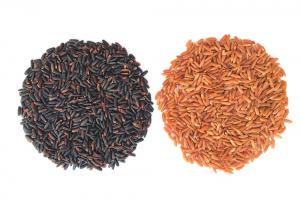Purple Rice Good For Heart Health
 ✖  |
The recently introduced USDA-Tiara purple rice will be better for the people who grow it and the people who eat it. The new, long-grain variety is resistant to major rice diseases, yields well and matures in 110 days. It also contains higher levels of antioxidants shown to benefit heart health.
“In addition to being higher in antioxidants than blueberries, Tiara is also an aromatic with a popcorn/buttery flavor when cooked,” says Anna McClung, USDA ARS. “It has a premium price in the market because of its novel characteristics and currently limited supply.”
McClung developed USDA-Tiara by crossing a medium-grain purple rice developed in Brazil with a long-grain rice from the U.S. The purple grain genetics had previously traveled to Brazil from China, where a famous black rice was called The Emperor’s rice.
“I named this new variety Tiara for a crown a princess might wear,” says McClung.
McClung previously developed and released Scarlett, a 120-day red rice in 2019. It also has good disease resistance.
Scarlett was the result of crossing a wild red rice, considered a weed by commercial rice growers, with a conventional, long-grain brown rice. If red rice shows up in commercial brown rice, the producer gets a lower price. The goal was to recover genes from the weedy rice to improve yield and productivity without the red bran.
“However, one of the selections from the cross had good yield potential and excellent long grain shape, but with the red bran,” says McClung. “We decided to release it as a specialty rice.”
It has proven popular with specialty rice producers in the South and as far north as the Pennsylvania border with New Jersey. “We are thrilled we have growers who have picked it up and are marketing it,” says McClung. “They’re often trying to get out of the commodity business. They have to do the hulling, packaging and marketing, but they’re jumping on and making it work.”
McClung has been looking for a foundation seed company to produce USDA-Tiara seed for sale to growers. “I’m now working with the Shoffner Foundation Seed program,” she says. “They already work with the purple rice from Brazil, as well as Scarlett, and are a good source for specialty colored rice.”
Contact: FARM SHOW Followup, Anna McClung, Dale Bumpers National Rice Research Center, 2890 Hwy 130 E., Stuttgart, Ark. 72160 (ph 870-672-6105; anna.mcclung@usda.gov).

Click here to download page story appeared in.
Click here to read entire issue
Purple Rice Good For Heart Health CROPS New Crops The recently introduced USDA-Tiara purple rice will be better for the people who grow it and the people who eat it The new long-grain variety is resistant to major rice diseases yields well and matures in 110 days It also contains higher levels of antioxidants shown to benefit heart health “In addition to being higher in antioxidants than blueberries Tiara is also an aromatic with a popcorn/buttery flavor when cooked ” says Anna McClung USDA ARS “It has a premium price in the market because of its novel characteristics and currently limited supply ” McClung developed USDA-Tiara by crossing a medium-grain purple rice developed in Brazil with a long-grain rice from the U S The purple grain genetics had previously traveled to Brazil from China where a famous black rice was called The Emperor’s rice “I named this new variety Tiara for a crown a princess might wear ” says McClung McClung previously developed and released Scarlett a 120-day red rice in 2019 It also has good disease resistance Scarlett was the result of crossing a wild red rice considered a weed by commercial rice growers with a conventional long-grain brown rice If red rice shows up in commercial brown rice the producer gets a lower price The goal was to recover genes from the weedy rice to improve yield and productivity without the red bran “However one of the selections from the cross had good yield potential and excellent long grain shape but with the red bran ” says McClung “We decided to release it as a specialty rice ” It has proven popular with specialty rice producers in the South and as far north as the Pennsylvania border with New Jersey “We are thrilled we have growers who have picked it up and are marketing it ” says McClung “They’re often trying to get out of the commodity business They have to do the hulling packaging and marketing but they’re jumping on and making it work ” McClung has been looking for a foundation seed company to produce USDA-Tiara seed for sale to growers “I’m now working with the Shoffner Foundation Seed program ” she says “They already work with the purple rice from Brazil as well as Scarlett and are a good source for specialty colored rice ” Contact: FARM SHOW Followup Anna McClung Dale Bumpers National Rice Research Center 2890 Hwy 130 E Stuttgart Ark 72160 ph 870-672-6105; anna mcclung@usda gov
To read the rest of this story, download this issue below or click
here to register with your account number.







